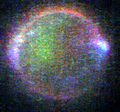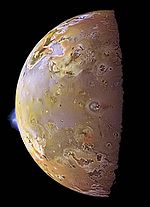Io (/ˈaɪ.oʊ/), or Jupiter I, is the innermost and second-smallest of the four Galilean moons of the planet Jupiter. Slightly larger than Earth's moon,...
114 KB (12,516 words) - 18:57, 10 October 2024
together, Jupiter's moons form a satellite system called the Jovian system. The most massive of the moons are the four Galilean moons: Io, Europa, Ganymede...
120 KB (6,789 words) - 14:46, 24 September 2024
eruptions on Jupiter's moon Io eject large amounts of sulfur dioxide gas into space, forming a large torus around the planet. Jupiter's magnetic field...
78 KB (9,072 words) - 20:43, 3 October 2024
The exploration of Io, Jupiter's innermost Galilean and third-largest moon, began with its discovery in 1610 and continues today with Earth-based observations...
95 KB (10,769 words) - 15:36, 31 August 2024
The atmosphere of Io is the extremely thin blanket of gases surrounding Jupiter's third largest moon Io. The atmosphere is primarily composed of sulfur...
13 KB (1,459 words) - 16:14, 1 October 2024
heliosphere). Jupiter forms a system of 95 known moons and probably many more, including the four large moons discovered by Galileo Galilei in 1610: Io, Europa...
176 KB (16,535 words) - 00:47, 11 October 2024
discovering the volcanic activity of Io and the presence of water ice on the surface of Europa. Ulysses further studied Jupiter's magnetosphere in 1992 and then...
67 KB (6,806 words) - 21:16, 29 September 2024
Volcanism on Io, a moon of Jupiter, is represented by the presence of volcanoes, volcanic pits and lava flows on the surface. Io's volcanic activity was...
56 KB (6,307 words) - 10:01, 4 September 2024
Galilean moons (redirect from Discovery of Io)
(/ˌɡælɪˈleɪ.ən/), or Galilean satellites, are the four largest moons of Jupiter: Io, Europa, Ganymede, and Callisto. They are the most readily visible Solar...
54 KB (5,530 words) - 18:57, 22 September 2024
Ganymede (moon) (redirect from Ganymede (moon of Jupiter))
surface gravity than Mercury, Io, or the Moon due to its lower density compared to the three. Ganymede orbits Jupiter in roughly seven days and is in...
112 KB (10,722 words) - 16:44, 5 October 2024










